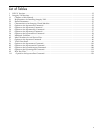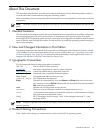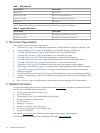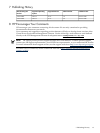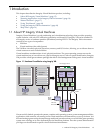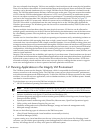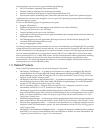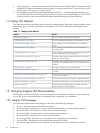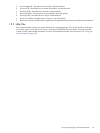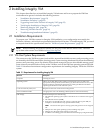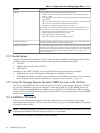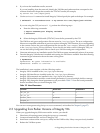
One way to benefit from Integrity VM is to run multiple virtual machines on the same physical machine.
There is no setlimit to the number of virtual machinesthat can be configured, but nomore than 256 virtual
machines can be booted simultaneously on a single VM Host. Each virtual machine is isolated from the
others. The VM Host administrator allocates virtual resources to the guest. The guest accesses the number
of CPUs that the VM Host administrator allocates to it. CPU use is governed by an entitlement system
that you can adjustto maximize CPU use andimprove performance.A symmetric multiprocessing system
can run on the virtual machine if the VM Host system has sufficient physical CPUs for it. Figure 1-1
illustrates how an HP-UX system and a Windows system can be consolidated on a single Integrity server.
The HP-UX boot disk is consolidated onto the same storage device as the VM Host boot disk and the
Windows guest storage. The Windows guest also has access to removable media (CD/DVD) that can be
redefined as necessary.
Because multiple virtual machines share the same physical resources, I/O devices can be allocated to
multiple guests, maximizing use of the I/O devices and reducing the maintenance costs of the data center.
By consolidating systems onto one platform, your data center requires less hardware and management
resources.
Another use for virtual machines is to duplicate operating environments easily, maintaining isolation on
each virtual machine while managing them from a single, central console. Integrity VM allows you to
create and clone virtual machines with a simple command interface. You can modify existing guests and
arrange networksthat provide communication through the VMHost's network interface orthe guest local
network (localnet).Because all the guests share thesame physical resources, you can be assured ofidentical
configurations, including the hardware devices backing each guest's virtual devices. Testing upgraded
software and system modifications is a simple matter of entering a few commands to create, monitor, and
remove virtual machines.
Integrity VM can improve the availability and capacity of your data center. Virtual machines can be used
to runisolated environments thatsupport different applicationson the same physicalhardware.Application
failures and system events on one virtual machine do not affect the other virtual machines. I/O devices
allocated to multiple virtual machines allow more users per device, enabling the data center to support
more users and applications on fewer expensive hardware platforms and devices.
1.2 Running Applications in the Integrity VM Environment
The VM Host system runs the Integrity VM software, which is responsible for allocating processor and
memory resources to the running guests. The VM Host system can run physical resource, performance,
and software management and monitoring tools. To allow the VM Host to allocate resources to the virtual
machines, do not run end-user applications, such as database software, on the VM Host system. Instead,
run them on virtual machines.
Typical software you can run on the VM Host includes the following:
• HP-UX Foundation Operating Environment (FOE)
NOTE: The HP-UX FOE and license is included with the Integrity VM media so that you can install
and run Integrity VM on the VM Host system. For HP-UX guests, you must purchase FOE licenses.
• Software installation tools (Ignite-UX and Software Distributor-UX)
• Hardware diagnostic andsupport tools to monitorguests (WBEM, online diagnostics,Instant Support
Enterprise Edition [ISEE])
• System performance monitoring tools (GlancePlus, Measureware, OpenView Operations Agent)
• Utility pricing tools (Instant Capacity, Pay per use)
• Hardware management tools (nPartition Manager, storage and network management tools)
• Multipath storage solutions
Do not run the following types of software on the VM Host system:
• vPars (Virtual Partitions and virtual machines are mutually exclusive.)
• Workload Manager (WLM)
A guest running on a virtual machine runs the way it does on a physical system. By allocating virtual
resources, you provide the guestoperating system and applicationswith access to memory,CPUs, network
devices, and storage devices as if they were part of a dedicated system.
16 Introduction




